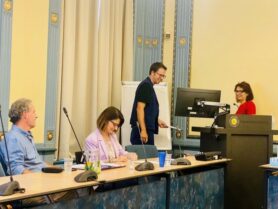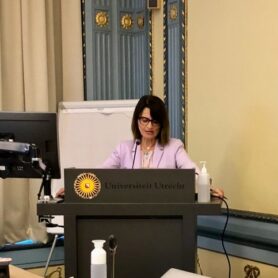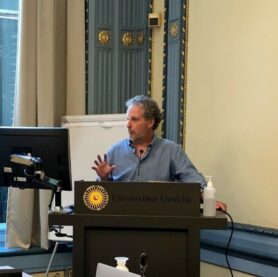Nieuws
Joint Book Launch & Discussion Event: Migration and borders in a digital and datafied world
Koen Leurs, associate professor at Utrecht University’s Department of Media and Culture/Graduate Gender Programme, hosted a joint book launch and discussion event under the theme Migration and borders in a digital and datafied world.
This hybrid event, facilitated by Kinan Alajak (Founder & Director of Refugee Wellbeing and Integration Initiative (RWII), and assistant researcher in the Media and Culture department) took place on 23 June at Utrecht University’s Drift 21 Sweelinckzaal and featured book talks, responses and open Q&A sessions with authors and editors.
Opening
In his opening Koen Leurs highlighted that the topic of the event is timely, given recent experiments of securitisation through lie-detection at EU borders, the use of 24/7 GPS tracking of migrants facing deportation in the UK, facial recognition and body scanners at airports or the use of sound-canons in Greece to deter migrants from approaching its borders. Recent events also remind us of how colonial racialised legacies shape contemporary perceptions and regimes of migration. Take the devastating Russian invasion of Ukraine and the subsequent EU response in welcoming Ukrainians fleeing war. This warm welcome starkly contrasts with the pushback of non-white, irregularized migrants at the Mediterranean or the purposefully delayed processing of asylum claims of non-white migrants in various nations in the EU. From the level of lived experience, we have observed how digital technologies have become part of the everyday practice – the growth of remittance flows, transnational networks, digital diasporas and local activist and solidarity initiatives.

As a result, digitisation and datafication fundamentally co-constitute migrant being and existence. In the last decade, various fields have begun to research the interplay resulting in the emergence of what can be called an interdisciplinary research area of digital migration studies. From this research area, questions regarding ontology, epistemology, methodology and ethics of researching migration and digital technologies are emerging.
The Digital Border: Migration, Technology, Power
In the first session, professor Myria Georgiou presented her book The Digital Border, co-authored with Lilie Chouliaraki. Georgiou invited us to fundamentally rethink how we understand the media’s responsibility toward migrants and how the media visually reproduce a moral order that provides the lens for western publics to consider their responsibilities and actions in the context of migration.

In particular, the book addresses the following questions: How do digital technologies shape the experiences and meanings of migration? What is the role of digital technologies in shaping migration today? How do digital infrastructures, platforms, and institutions control the flow of people at the border? And how do they also control the public narratives of migration as a “crisis”? Finally, how do migrants themselves use these same platforms to speak back and make themselves heard in the face of hardship and hostility?
Subsequently, Professor Huub Dijstelbloem of the University of Amsterdam and Professor Sandra Ponzanesi of Utrecht University offered their responses, inviting the authors to consider de-mediation and cosmopolitanism in the context of the digital border.
Borders as Infrastructure: The Technopolitics of Border Control
In the second session, professor Huub Dijstelbloem of the University of Amsterdam presented Borders as Infrastructure. In this book, Dijstelbloem brings science and technology studies and the philosophy of technology to the study of borders and international human mobility. He offers an investigation of borders as moving entities that influence our notions of territory, authority, sovereignty, and jurisdiction.

Taking Europe’s borders as a point of departure, Dijstelboem shows how borders can transform, multiply, and mark conflicts over international orders. The philosophies of Bruno Latour and Peter Sloterdijk provide a framework for Dijstelbloem’s discussion of the material and morphological nature of borders and border politics. He offers detailed empirical investigations that focus on the so-called migrant crisis of 2014–2016 on the Greek Aegean Islands of Chios and Lesbos; the Europe surveillance system Eurosur; border patrols at sea; the rise of hotspots and “humanitarian borders”; the technopolitics of border control at Schiphol International Airport; and the countersurveillance by NGOs, activists, and artists who investigate infrastructural border violence.
Myria Georgiou, Professor of Media and Communications at the London School of Economics, responded to Prof Dijstelboem. In her response, she invited the author to reflect on the possibility of if and how we see the breaks, flaws and limits of the border through an infrastructural perspective, as well as how to attend to the normativity and historicity of borders through STS perspectives.
Albert Meijer, a Professor of public innovation at Utrecht University in the Netherlands and chair of the Public Management Group, invited the author beyond critique to reflect on how borders can be constructed differently on the basis of multi-stakeholder consultations.
Unruly Speech: Displacement and the Politics of Transgression
In the third session, Associate Professor Saskia Witteborn of the School of Journalism and Communication at The Chinese University of Hong Kong (CUHK) presented her book Unruly Speech. The book discusses disruptive communication practices, their sociopolitical moorings, and socio-technical control in the context of a transnational China. The book is essential to migration, language and social interaction, and digital surveillance scholars.

Criminologist Dr Veronika Nagy of Utrecht University and Dr Nerina Boursinou, research Fellow at the University of St Andrews, responded on their reading of Professor’s Witteborn book.
“This ethnography not only triggers new interpretations of Uyghur diasporas in the digital migration framework but also introduces or revokes a new understanding of the roles of semantics, techno-sociolinguistics and narrative approaches. With this ethnographic review, similar to James Joyces` Ulysess, Saskia seems to challenge sociopolitical normativities and demystify migration prophesies of traditional disciplines. Her reflection on the Master narrative on displacement through the description of naming practices and witness accounts of Uyghurs, creates a new technosocial meaning of belonging, and instrumentally turns those into tools of activism and confrontation. Accordingly, the Master narrative on Uyghurs is deconstructed in interaction with migrants` individual accounts and critically analyzed as a transhistorical narrative that is deeply embedded in the particular digital culture of research participants.”
— Veronika Nagy, Utrecht University
“Saskia’s book, together with the rest of the books presented today, provokes us into thinking harder about the nature of solidarities to be built between the wider society and the minorities pushed “in the margins”, as well as the means to do it. Technology here has a leading role.”
— Nerina Boursinou, University of St Andrews
Data Science for Migration and Mobility
In the fourth session, Professor Albert Ali Salah of Utrecht University and Tuba Bircan, Research Professor of Vrije Universiteit Brussel, co-editors of the book Data Science for Migration and Mobility, gave a presentation that sought to account for the deployment of data science to account for how migration is a complex phenomenon with multi-dimensional factors.

With ever-expanding data storage and processing capabilities, new data sources (such as social media, mobile call data records, and satellite imaging) are becoming available to study migration from both qualitative and quantitative perspectives. Their book addresses the needs of both migration scholars who stand to benefit from the analysis of these new sources but lack the computational tools, as well as data scientists who have practical and theoretical knowledge in dealing with these data sources but have no familiarity with the relevant questions of migration research.
“The book helps us trace various issues and assumptions that need to be accepted in doing data science projects on migration and mobility: representativity, noise sources, accessibility, reproducibility are but a few. The book is written for a budding data scientist who also has an interest in the analysis of people on the move. Its readers would do well combining their reading of this instructive guide with more critical readings about the power and politics of categorization and formalization in an area of research where the human costs of those categorisations can be staggering. The book makes the central assumption that migration research ought to in part be about predicting migration. An assumption that requires critical debate.”
— Fran Meissner, University of Twente
I really appreciate how this book successfully mobilised a diverse mix of scholars, a truly interdisciplinary endeavour. As a result, this book demonstrates both depth and breadth in presenting the state-of-the-art on data science for mobility and migration, as well as balancing scientific and practical value.”
— Tijs van den Broek, Vrije Universiteit Amsterdam

